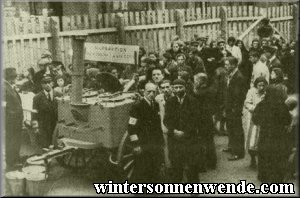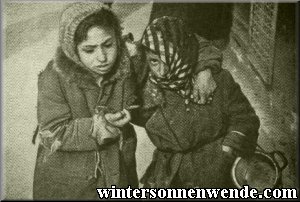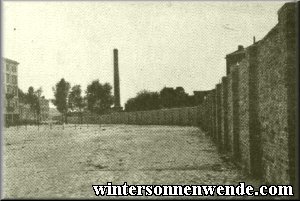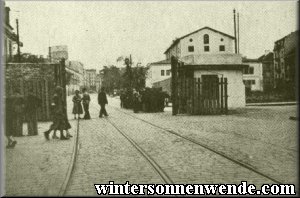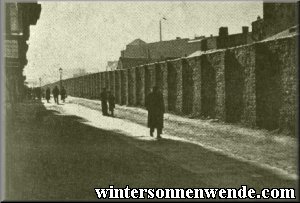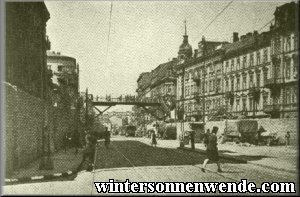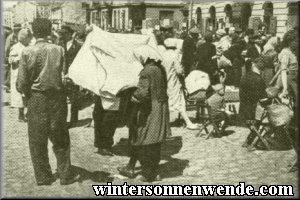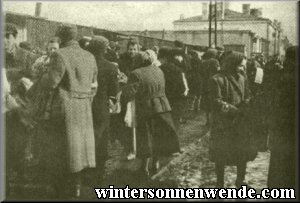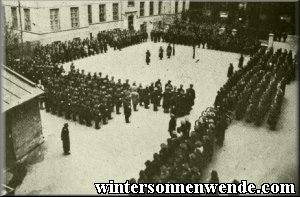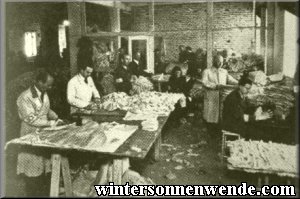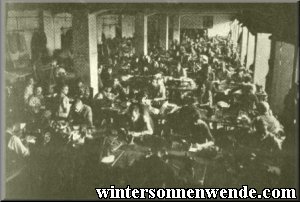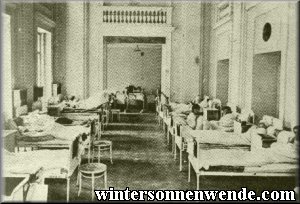 |
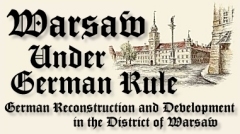 For this chapter in particular,
please note our position on censorship! The Ethnic Groups in the District of Warsaw
1. Treatment of the Ethnic Groups, Past and Present
Painstaking research has shown that the true ethnic Poles comprise only 59.3% of the total, that is, not even two-thirds of the population as a whole. Even official Polish statistics place the proportion of the Polish ethnic group at only 69.2%. These figures show best how nonsensical the Polish propaganda about "Polish living space" was. And Polish nationalists had even endeavored to expand their former state by annexing more land and territory to the Republic of Poland! Their demand, "Polska od morza do morza" – "Poland from sea to sea" – refers to the hoped-for creation of a Polish nation extending from the Baltic Sea in the north to the Black Sea in the south, from the Oder River in the west to the Dnieper River in the east. These megalomaniac ideas are out of all proportion to any realistic Polish territory inhabited by a true Polish ethnic group. This is why the former Polish state did everything in its power to "Polonize" the non-Polish ethnic groups living within its boundaries, or at least to suppress them. Individual ethnic groups were never given any sort of special care. Rather, the Polish interim state of 1919–1939 was a veritable fortress within whose walls the German and Ukrainian ethnic groups in particular were deprived of all rights. The General Government has taken on a part of the many ethnic groups from earlier days. The people living under the General Government are also not one single self-contained ethnic group, but rather the sum of numerous large and small ethnic fragments. At the beginning of 1942 the numerical strengths of the individual ethnic groups under the General Government's jurisdiction were as follows:
Resident in the District of Warsaw are some 2.8 million Poles, roughly 600,000 Jews, approximately 6,000 Russians, 5,800 Ukrainians, 5,000 Polish East Galicians, and 500 Caucasians [ie. from the Caucasus Mountains] consisting of Georgians, Armenians, Azerbaijanians and Tatars. There is also the ethnic German group, of which 6,000 members have already been resettled into the Reich proper from the region east of the Vistula. The German Administration's foremost concern was naturally the ethnic Germans, as these had previously been singularly oppressed in legal, social and economic respects. The sheer magnitude of this oppression is shown by the fact that more than 50% of the ethnic Germans in Warsaw were employed in the most menial jobs and could barely maintain a meager subsistence level. Also, many had been sent to the concentration camp Bereza because of their Germanness, where they were subjected to great hardship and harassment. When the German Reich took over the Vistula region it was the foremost duty to place the ethnic Germans under the protection of the Reich. The debt which the German Reich owes the 58,000 murdered ethnic Germans can be best paid by caring for the Germans still living. In dealing with matters of ethnic German concern, the question arose: just exactly who can be considered an ethnic German? For as it turned out, thousands who had never owned their German affiliation before the war now suddenly applied for an ethnic German identification card. In the city of Warsaw alone, more than 10,500 such applications were received, even though prior to the war only some few hundred had openly acknowledged their Germanness through membership in German organizations. By the close of the identity card campaign at the end of May 1942, 22,455 identity cards had been issued in the District of Warsaw. This number is distributed among the various county precincts as follows:
In order to grant the opportunity of returning to German ancestry to all those who do not yet meet the criteria for the issue of an identity card, or who do not meet these criteria fully, an identity card attesting to German origin was created which can on the whole be issued to anyone who has German ancestors but does not possess German citizenship or the ethnic German identity card. Even though this registration was only begun in June of 1942, it is already evident that a great number of applications may be expected for this identification as well. To get an idea of the degree to which Polish society is interspersed with German blood, it suffices to take a look at storefront signs, many of which bear German, that is, Polonized German names. Cultural and social care given to the ethnic Germans was initiated on a large scale; in particular, public care facilities such as kindergartens, grocery and clothing distribution centers and German grocery stores were set up. Further, the relief organization "Mother and Child" sent a large number of mothers and children away to sanatoriums for rest and convalescence. A German Seniors' Home and an orphanage – the only such German institutions in the General Government – were established in the city of Warsaw. Regular support has helped to meet the most pressing needs, and assistance is still given regularly to the needy. It is a matter of course that the many cultural assets more recently created and hence new to the Germans in Poland are now as freely available to the ethnic Germans as to the Germans of the Reich proper. The existing social institutions were also maintained for the Polish inhabitants of the District. The Polish people had suffered much hardship as a result of the war, particularly in Warsaw due to the city's siege and bombardment. It is therefore no surprise that Poles have thronged to the welfare institutions in vast numbers. But as these had closed their doors with the collapse of the Polish state, it was first necessary to restore the state-run care and independent welfare institutions to working order on the initiative of the German Administration. In doing so, it proved to be necessary to consolidate the widely scattered forces of the independent welfare institutions and to completely reorganize their work. The Polish Central Committee in Cracow was set up for this purpose. Its organization is comprised of Polish Relief Action Committees established under the authority of the County and City Administrators, and these committees in turn set up delegacies in cities and collective communities to provide local relief. The work of the Relief Action Committees consists essentially of the centralization of all organizations active in the independent provision of welfare, of the maintenance and support of care homes and other welfare institutions, and of the distribution of donations and foreign alms to those people in need of assistance.
The responsibilities of the Polish Relief Action Committee in Warsaw are especially great. In that city, the Committee maintains no less than 126 soup kitchens which distribute 110,000 hot meals daily. On state suggestion, this Committee has also carried out an allotment garden project which serves to bring unexploited land into production. Another major sphere of action involves rendering assistance in rebuilding lives from the ground up, as it were, and caring for needy persons who are not being looked after by a community. If one compares these public welfare measures taken for the good of the Polish populace with the hardship and harassment which the ethnic German minority suffered at the hands of the Polish authorities prior to the war, the contrast shows most clearly the fundamental difference in attitude which has established itself here in Poland with respect to the ethnic question. Mention must also be made of the other non-Polish foreign ethnic groups, as these are particularly strongly represented in the city of Warsaw. The greatest part of them are emigrants who have escaped from Russia since 1920. During the time of Polish rule, they too were severely neglected and discriminated against due to their ethnicity, and hindered in their development. For the German administration it has been a matter of principle to accord to the foreign ethnic groups the chance to freely develop their unique nature, and to grant them assistance as part of cultural advancement programs wherever the political situation permits. These ethnic groups were further given the opportunity to establish a committee in Warsaw and delegacies in the various towns of the District for purposes of registration and care of the fellow members of their ethnic minorities. The Russian Committee has availed itself of this opportunity and established two delegacies in Wolomyn and Zyrardow. The Ukrainian Committee has even set up nine delegacies, including establishments in Sochaczew, Siedlce, Sokolow, Lowitsch, Zyrardow, Grojec, Rembertow and Pruszkow, while the Polish East Galician Committee maintains two delegacies, in Minsk and Siedlce. The responsibility for providing welfare services were also transferred to these Committees, towards which purpose they were granted large-scale financial support. The Russian Committee maintains a soup kitchen where 200 to 250 people are fed every day; the soup kitchen of the Ukrainian Committee even provides for 800 persons daily. Besides these minority groups, other small ethnic groups such as the Lithuanians, Cossacks and gypsies are also present in the District. The treatment given these ethnic groups shows that under German administration, the former oppression of alien ethnic groups has ended and that everyone can live in the General Government in accordance with his ethnic traditions. The exception to this rule, of course, is anyone who attempts to sabotage German reconstruction and development out of political fanaticism. It goes without saying that such subversive elements are rooted out with all necessary rigor.
 2. The Jews in the District of Warsaw
a. The Situation When the German Administration Took Over
The "German" Jews brought their reinforcements in from the eastern countries, particularly from Poland. When they arrived at the Silesian Train Station in Berlin they still wore their caftans. The streets east of Alexander Square were swarming with East European Jews. But it was not long before they adapted their exterior to their surroundings and moved into the western parts of the city and finally into the exclusive residential suburbs of Berlin. The Germans who came to the occupied Polish territories in October of 1939 were therefore prepared to encounter here the place of origin of all these Eastern European Jews. In fact, the large Jewish population sector
Just as in Germany and other Central and Western European countries, the Jews in the Republic of Poland had also known how to obtain decisive influence in all aspects of daily life. They held Polish offices, played a role in cultural life, and most of all, pulled the strings of industry, commerce and trade. However, a significant difference between the conditions in Poland and those in Germany was the fact that here in Poland the majority of the Jews did not appear as merchants or intellectuals, but rather that there were great numbers of Jewish craftsmen and manual workers to be found as well. Under these conditions, the German administration not only had the responsibility of breaking the Jewish hold on economy and culture which still persisted after the Polish Campaign, but rather, first and foremost, saw itself faced with the problem of dealing with a numerically extraordinarily strong Jewish population sector. In this regard the situation was especially difficult in Warsaw. Of the city's 1.2 million inhabitants, approximately one out of every three was a Jew. In some city districts Jews constituted 80% and even 90% of the population. The cityscape as a whole showed clearly the omnipresence of the Jews.
 b. The Necessity of Establishing Jewish Residential Quarters The Jews who had not already "made it" and moved into the Polish suburbs were on the whole living in conditions of hygiene that simply defy description. The streets of the Jewish quarters were crowded with a milling mass of pushing, haggling, gesticulating Jews reminiscent of Oriental bazaars. The back yards and residences, which at times had to be entered in the course of police raids, exhibited a degree of dilapidation and filth the likes of which one will be hard pressed to find anywhere else. These city districts were also the hotbeds of typhus and typhoid fever, dysentery and other infectious diseases. Any attempts to protect the members of the German Wehrmacht, officials and the Polish people from any major epidemics would have been doomed to failure from the start until the Jewish hearth of such pestilence had been more or less confined. This was the first and also the most compelling consideration indicating the need for segregated Jewish residential quarters. There were also other, no less serious considerations. The legal measures that had been taken to extract the Jews from cultural life and the economy did have a certain degree of success. But as the early times of German administration wore on, it became ever more obvious that measures of this sort would not be enough in the end. This also necessitated a spatial aggregation of the Jews. And finally, segregated Jewish districts were the only way to rid the city streets of their Jewish character. It would have been intolerable in a major city such as Warsaw to bump into Jews everywhere one went and to put up with all the problems that cannot help but arise whenever Jews enjoy total freedom of action in any territory under German sovereignty. A Jewish residential quarter was thus already established in the city of Warsaw in 1940 – earlier than in any other district of the General Government.
 c. The Jewish Residential Quarter in the District of Warsaw
Discussions about the establishment of one or more Jewish residential quarters in Warsaw commenced in the spring of 1940. At first the creation of two Jewish quarters on the outskirts of the city was considered, but in the end it was decided instead to establish one single Jewish district in that area of town which was already most densely populated by Jews anyhow: at the location of the existent epidemic isolation zone. Resettlement measures affected some 700 ethnic Germans, 113,000 Poles and 138,000 Jews. 11,500 non-Jewish residences in the Jewish quarter and 13,800 Jewish residences in the remainder of the city were given up. The numbers of originally present Jews – slightly more than 400,000 – were increased further because the Jews living in the western parts of the District were moved into the Jewish quarter in February and March of 1941.
In terms of administrative structure, a Jewish Council was set up in Warsaw as early as 1939 to serve as representation for the Jews. It consists of 24 members under the leadership of a Representative. This Representative of the Jewish Council has been granted the authority and responsibilities of a mayor,
At first, German supervision was one of the duties of the Chief of the Resettlement Unit. Later, the office of Commissioner for the Jewish Quarter was created. The Commissioner, who is directly accountable to the District Governor, supervises the Jewish administration in the same capacity as a City Administrator would. As mentioned in a previous section of this book, the Transfer Point Warsaw, constituted as a public institution, was set up for purposes of the regulation of economic interaction between the Jewish Quarter and the outside. This is a strictly German institution and also comes under the charge of the Commissioner for the Jewish Quarter. It serves to monitor the economic and trade activities of the Jewish Quarter. In accordance with the responsibilities assigned to it, the Jewish administrative organization is staffed exclusively by Jews and controls all aspects of community administration. For example, the Chairman of the Jewish Council presides over a separate Health Department, a Housing Office, a Registration Office, a separate Taxation and Revenue Department, etc. Further, a number of additional institutions have been set up in the Jewish Quarter of Warsaw whose purpose is to ease the burden of
In the area of economics, a number of measures have been taken to turn the Jewish work force to good account. Jewish workshops and factories with ever-increasing numbers of employees have been filling orders placed by the Aryan economy, particularly by and for the Wehrmacht. Food and other requirements are obtained by the Supply Agency for the Jewish Quarter which, under the supervision of Transfer Point Warsaw, purchases the goods required and distributes them within the Jewish Quarter according to the Commissioner's directions. Besides the Jews living in the Jewish Quarter of Warsaw, some 110,000 more Jews live in the eastern parts of the District. Some of these Jews are grouped together in several smaller closed residential quarters, such as in Siedlce and Sokolow; the remainder live in larger, open Jewish communities.
 d. The Lessons of Experience The Jewish Quarter in Warsaw has now been in existence for over two years. The experiences gained during this time are of great value to an assessment of whether or not the measures taken to date have been successful.
It has, however, become equally apparent that the protection of the Aryan people from typhus fever cannot be absolute if segregation of the Jews is not carried out with the necessary rigor. The location of a large Jewish quarter in the midst of a major city requires that borders be clearly defined and that all inappropriate sentimentality be dispensed with in the task of patrolling these borders. It is further necessary to create similar conditions in as large a border area as possible, so that there is no incentive for the Jews to leave their Jewish district. Experience has shown that even with as problematic an institution as a Jewish Residential Quarter with at times up to 500,000 inhabitants, satisfactory results can be obtained in economic respects as well, but the prerequisite for this is an effective mediation such as is provided by the Transfer Point Warsaw. One aim always to be kept in mind must be the application of the Jewish labor force in such a way that it will bring the greatest possible benefit to the war effort. At the very least, a level of productivity must be achieved whose value covers the cost of the Jews' living requirements, so that the Jewish Quarter does not create a drain on welfare provisions. Experience with the Jewish administrative apparatus has shown that the organizational talents of the Jews are not commensurate with their average intelligence. Despite an abundance of employees, committees and meetings, the Jews rarely manage to bring order into a situation by dint of their own efforts. Among themselves they display blatant egotism. The social services they perform cannot cover up the fact that each of them is ultimately concerned only with his own advantage. They are far from being a united community. On the other hand, their representatives are generally satisfactory in carrying out the instructions of the German supervisory body. It has proven to be the correct policy to restrict German direction to a supervisory function performed by a relatively small number of Germans, and to leave administration per se in the hands of the few organizationally capable Jews.
It goes without saying that all these measures are only temporary solutions pending the final resolution of the Jewish question. |





